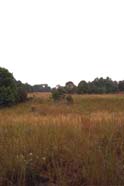
 |
| Savanna |
Parts
of a forest
The living
parts of a forest include trees, shrubs, vines, grasses and other herbaceous
(non-woody) plants, mosses, algae, fungi, insects, mammals, birds, reptiles,
amphibians, and microorganisms living on the plants and animals and in
the soil.
These interact with one another and with the non-living part of the environment - including the soil, water, and minerals, to make up what we know as a forest.
How
many trees make a forest?
Forests
(according to the U.S. National Vegetation Classification system) consist
of trees with overlapping crowns forming 60% to 100% cover. Woodlands
are more open, with 25% to 60% cover.
Other classification systems recognize savannas, which are discussed in this Web site, as having widely spaced trees with anywhere from a minimum of 5 - 10 % cover to a maximum of 25 - 20% cover.
Many
definitions of forest
Today, there are more than 250 definitions of the term "forest." These definitions differe based on the emphases or concerns of different people.
A legal definition is different from an ecological definition. The perspective of the economist differs from that of a geographer. All definitions stress the importance of trees in the system and include places where tree cover ranges from 5% to as high as 100%.
|
|
Copyright © 2000 Illinois State Museum